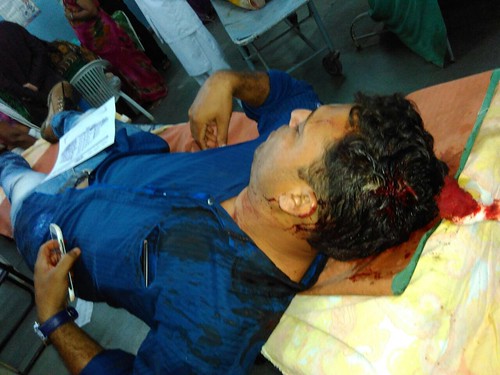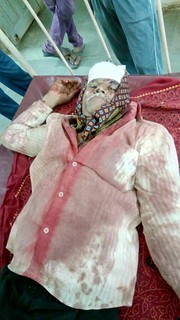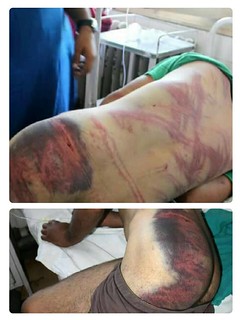By Amit Kumar. TwoCircles.net
The Dalit Asmita Yatra, organised in the wake of attacks on Dalits in Una, Gujarat by cow vigilantes might have got over, but it is clear that the after effects of the rally remain. On 13th August 2016, two days before the rally was scheduled to end with flag hoisting in Una, Dalits were attacked on their way to the rally; pelted with stones and told to stay away from Una.
And although it has been close to a month since the rally got over, it is also evident that upper castes are in no mood to relent. The mobilisation among Dalits, and Muslims to a certain extent, coupled with the pledges to not dispose dead cattle has left upper-castes fuming and as a result, the Dalits are now facing the wrath of these forces. Since the rally got over, in areas like Una, Amerli, Surendranagar, Ahmedabad, Botad and even Kutch, Dalits have been at the
receiving end of attacks.

On Sunday, a Dalit teacher, Rameshbhai, was attacked by the Darbar community in Lodhika Taluka, Rajkot district while he was teaching. A couple of days ago, a Dalit man and his elderly father (in pictures) were attacked in Kutch district. Reason? He honked at the goats owned by the Darbar community. The Darbars, a powerful Kshatriya community, have been at the helm of anti-Dalit protests and have vociferously come out in support of the Gau Rakshaks. Meanwhile, in Samter, a village about 7 kms from Una, the Darbars have wrecked havoc with the lives of Dalits, attacking them with vengeance. In Samter, things have got so bad that as this report in Times of India shows, Dalits are now considering fleeing this village, with little or no hope of coming back.

All this, ever since Dalits, who constitute less than 8% of the state population, decided to rise up against centuries of abuse, exploitation and torture. How did things go so bad in a state which has for the last decade, been presented as the ideal state; the state which would act as the torch bearer to the rest of India?
To understand this, let us rewind to the evening of August 10.
The night of August 13
The Dalit Asmita Yatra had been going on in full swing: this correspondent, who had joined the rally in Gadhada on August 10, had been told that the rally in the previous destination, Botad, had been one of the biggest; attended by thousands. In Gadhada, the rally was attended by almost 1,000 people; all pledging to never touch or skin a dead animal ever again. Watched on intently by other communities and the ever-present police, the rally had been gaining strength; Dalits were coming out on the streets, displaying the posters of Ambedkar, shouting slogans against the Narendra Modi regime and most importantly, calling out the Gau Rakshaks and daring them to show their faces again.
Ever since Nattu Bhai Parmar and his colleagues had thrown dead carcasses in front of the collector’s office in Surendranagar on July 16 to protest against the Una attacks, the Dalits in Gujarat had defied all orders, pleas and even threats from the central and state government to show that this time, their protests would be heard loud and clear across the length and breadth of the country. Due to the mobilisation around Una, Jignesh Mewani, who had until then been known mostly in Gujarat, became a national figure.

The movement had gained national attention in ways that left the BJP and its supporters stunned; not since the heydays of Modi mania had so much media descended onto a town in Gujarat. The only difference was that this time, everyone wanted to “expose” the claims made by Modi and his leaders.
All this had left the upper-castes, especially the Darbars, fuming. However, bar one or two sporadic incidents, the rally had gone on without any issue: not the least because every step of the rally was watched, monitored and followed by police: the rally sure had a lot of support, but one cannot imagine what the situation might have been had there been no police.
As the rally progressed to Dhasa to Damnagar to Savarkundla, Rajula, and other parts of Amreli district are unlikely to remain safe and on August 11 and 12, the mood among the organisers, namely the Una Dalit Atyachar Ladak Samiti, had been extremely optimistic. People like Jayesh Solanki, Subodh Parmar, Shamshad Pathan had indicated to this correspondent that almost 1 lakh people were expected in Una on August 15. On August 13, the rally reached Timili village, and with only 20 kms separating the rally from Una, and the feeling was that of hope, and happiness as they halted in Timli. However, the mood soon turned into that of anger and despair as the first wave of violence hit the Yatra on the evening of the 13th. Dalit Camera, which was the first media house to reach the village of Samter. The video, which can be watched here, shows how tense the village was, and more importantly, that the upper castes had simply been waiting for the right time to strike. The final trigger was when some Dalits shouted provocative slogans like “If cow is your mother, who is your father/cow is your mother, dog is your father”.
By 13th night, the first casualties of violence, the Dalits, had already been admitted in Una Civil Hospital. Many more would follow.

On August 14, as the rally began its final leg, Rahul Sharma, an IPS who had been an important part of the rally since its inception, cautioned the people present to not raise any slogan that bordered on abuse. However, the cavalcade of the Dalit Asmita Yatra had barely travelled 10 kms before they were told that the state highway to Una had been blocked, in Samter (where else?).
The police, however, were in no mood to remove the blockade; on the contrary, it watched silently as this correspondent, along with a member of Dalit camera, were heckled and assaulted. However, both of us were able to get important interviews, which can be watched here and here, with the protesting Darbars, who said on camera that there was no way they would let the rally proceed. They believed that the Gau Rakshaks had in fact, been kind to the Dalits in Una (who they said had killed the cow for consumption). “No one was killed,” they said, almost surprised as to why the Dalits were protesting at all.
Four hours later, once the Dalit Rally had taken a huge detour to reach Una, the blockade had been removed: how did that happen? The police knows best. However, the mobilisation on the last day was foiled completely, and over the course of the day, Dalits continued to be attacked as they tried to make their way to Una.
The police, meanwhile, watched on, refusing to arrest anyone.
On August 15, the rally did however take place but even the most optimistic estimates put the crowd at around 20,000, much below the 1 lakh figure quoted by the organisers. Worryingly however, during the entire day Dalits who were going back, or even coming to Una, were attacked. The situation got worse as all the UDALS leader including Jignesh Mewani made a beeline for Ahmedabad. During the day, more than 50 Dalits were admitted in just Una Civil Hospital, with some receiving serious minor injuries. It was only in the evening, after day-long protests, that the Police finally cracked down on Samter, and arrested more than 10 people for rioting. A number of vehicles were torched; more than 100 bikes were brought back to the Una Police station and as the day finally got over, it became clear that while the Dalit rally was a success in many ways, the backlash against them showed that the fight was likely to continue for the time being.
The government, on the other hand, remains a mute spectator, and instead of cracking down, tried to pacify the Dalits by holding its own meeting hosted by Dalit leaders from BJP. However, as this report from Telegraph India shows, it ended in a fiasco. According to estimates, more than 50 Dalits have been attacked after Una, and it is unlikely that the perpetrators are going to be punished.
And while it is true that Mewani has managed to get unimaginable coverage for Una and highlight the issues that plague the Dalits in the region, it is unlikely that their demands, which includes 5 acres of land for every Dalit family and compensation for Safai karamcharis at par with the 7th pay commission are going to be met. In such a situation, the UDALS has said that they would do a Rail Roko (Stop the train) movement across the state. The impact of that remains to be seen, but there is a high chance that the Dalits of Gujarat, who have taken on the high and mighty, will continue to face such attacks. One wonders what Narendra Modi, our Prime Minister, has to say about the situation in his home state. But then, what will he say, which we do not know of already?
